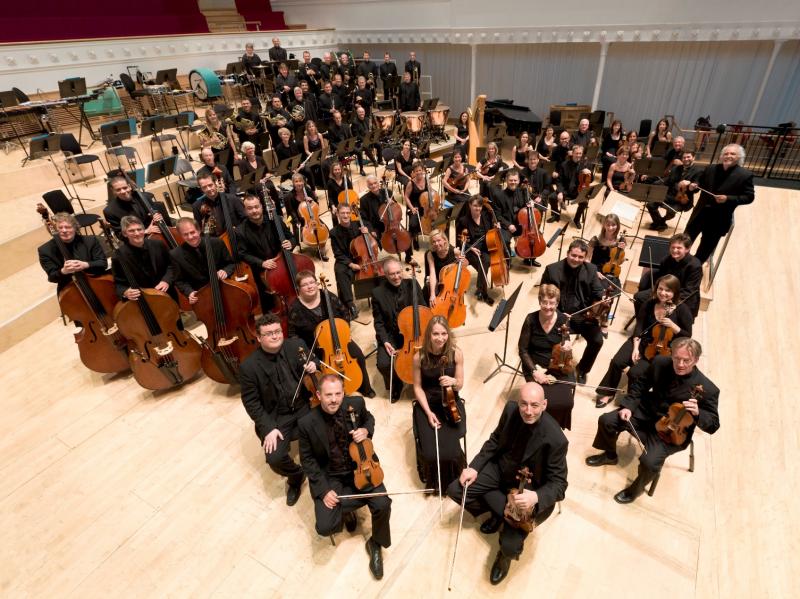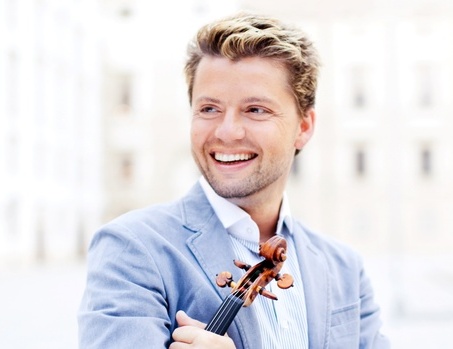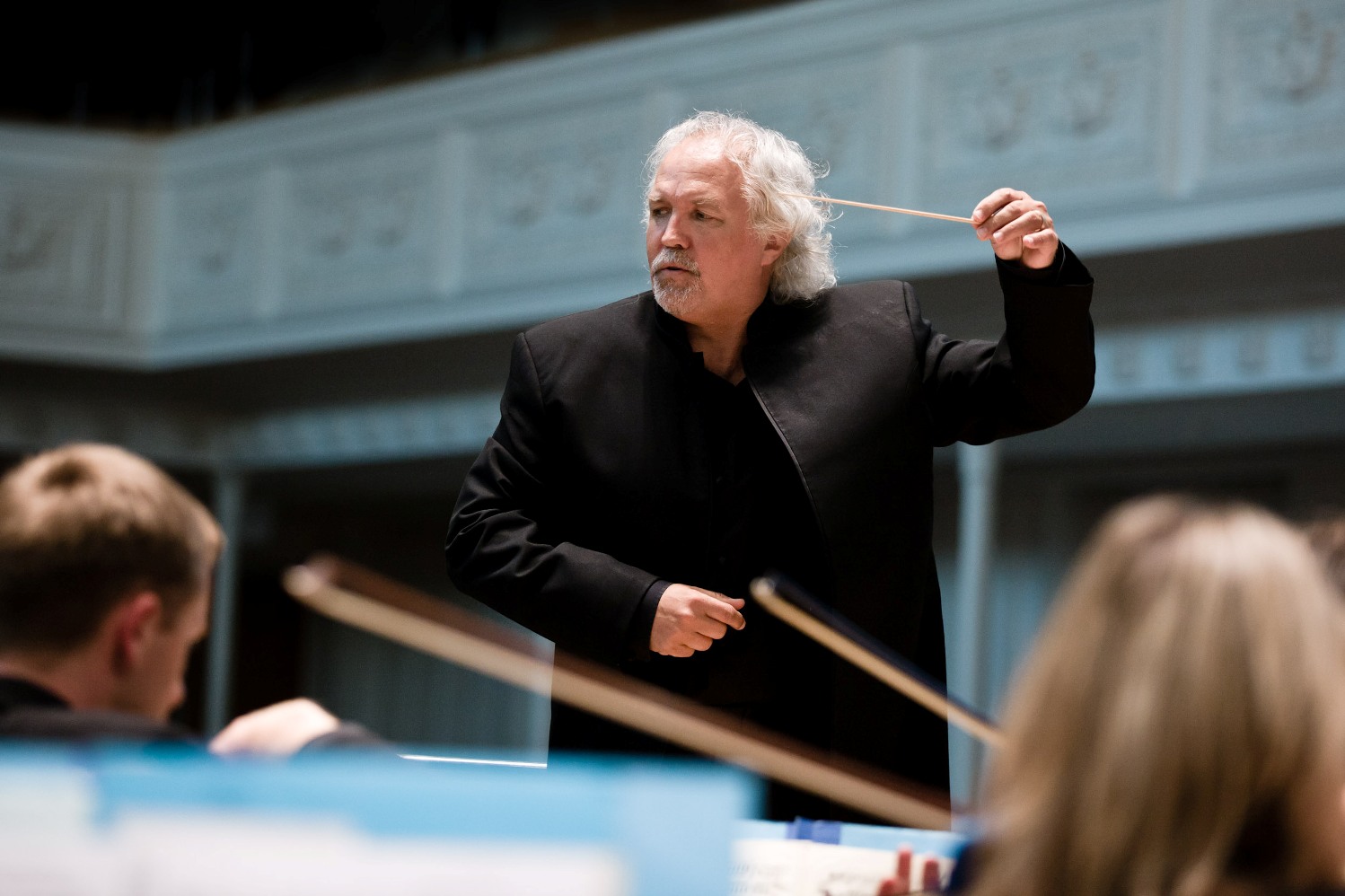Rachlin, BBC Scottish Symphony Orchestra, Runnicles, Glasgow City Halls | reviews, news & interviews
Rachlin, BBC Scottish Symphony Orchestra, Runnicles, Glasgow City Halls
Rachlin, BBC Scottish Symphony Orchestra, Runnicles, Glasgow City Halls
Viennese classics from Beethoven to Berg via the Blue Danube in a strong programme from this superb team

Viennese night in Glasgow’s Candleriggs was hardly going to be a simple matter of waltzes and polkas. True, its curtain-raiser was a Blue Danube with red blood in its veins rather than the anodyne river water of this year’s New Year concert from Austria’s capital; one would expect no less from Donald Runnicles after the refined but anaemic Franz Welser-Möst.
What a pleasure it was to be back at the heart of the dazzlingly refurbished City Halls, in a shoebox auditorium which feels like a more intimate version of Vienna’s Musikvereinsaal without the gilt. Given its fresh acoustics and a mid-range complement of BBC Scottish Symphony Orchestra strings, the subtler brass and woodwind details shone through and even Berg’s spider-web of sound in his concerto to the memory of 18-year-old Manon Gropius rarely proved an obstacle to the projection of that hyper-refined violinist Julian Rachlin (pictured below by Julia Wesely).
 You knew you were in for a treat when he warmed the white-note undulations of Berg’s sensitive start with selective vibrato. Rachlin plays more chamber music than most of the world’s star soloists, so his careful journey through the minefield left plenty of spotlight for the orchestral solos so carefully integrated by a footsure Runnicles, including a piercing line from principal trumpeter Mark O’Keeffe and sterling work from tuba-player Ben Thomson.
You knew you were in for a treat when he warmed the white-note undulations of Berg’s sensitive start with selective vibrato. Rachlin plays more chamber music than most of the world’s star soloists, so his careful journey through the minefield left plenty of spotlight for the orchestral solos so carefully integrated by a footsure Runnicles, including a piercing line from principal trumpeter Mark O’Keeffe and sterling work from tuba-player Ben Thomson.
The central death struggles were appropriately shattering, but the best came last: after the wan variations on Bach’s arrangement of a valedictory Lutheran chorale, the ghostliest of white lights shone on the waltz tune as if it had already crossed over to the other side. It was a wonderful idea to bring Rachlin back for a post-concert airing of the 19-year-old Schubert’s blithe, uncomplicated Violin Sonata in D major, D384. Here he was nimbly complemented in runs and unisons by Runnicles at the keyboard, sounding like a Schubertian as much to the manner born as Imogen Cooper or Elisabeth Leonskaja.
While Webern’s Schubert, for all its modern-sounding offbeats, followed the more wraith-like line in sparse trios – enthusiastic leader Laura Samuel as poised as Rachlin for her moment in the sun – the big waltz and the symphony found Runnicles at his focused, muscular best. The BBC strings may lack the sensuousness of the Vienna Philharmonic in waltz-lilt, but Runnicles has such instinct for the essential freedom of the idiom which On the Beautiful Blue Danube embodies.
It reminded me why one of the world’s leading interpreters of Baron Ochs in that later, unrelated Strauss - Richard’s - Der Rosenkavalier declares the Scots conductor the best he’s ever worked with on that opera. Clearly it's Runnicles (pictured below) whom the Vienna Philharmonic needs for a New Year's Day concert with far more potential panache than the one in 2013. Johann Strauss the Younger's very Austrian, dewy introductory duet of cello and first horn gleamed, while at the other end of the scale the most riotous of the waltz strains was given its head in an unusual repeat.
 He also found time for the repeats in the outer movements of Beethoven’s Fifth Symphony (though not the one in the scherzo, following the composer’s cue). I was reminded of what Sviatoslav Richter, according to Leonskaja, used to say to students who didn’t observe repeats: “What, you don’t love this music?” Runnicles so clearly does, but with rigorous focus and an accompanying care to observe every dynamic and every nuanced phrase.
He also found time for the repeats in the outer movements of Beethoven’s Fifth Symphony (though not the one in the scherzo, following the composer’s cue). I was reminded of what Sviatoslav Richter, according to Leonskaja, used to say to students who didn’t observe repeats: “What, you don’t love this music?” Runnicles so clearly does, but with rigorous focus and an accompanying care to observe every dynamic and every nuanced phrase.
His conducting was clear enough to remind us that the opening gesture doesn’t begin emphatically on the first beat of the bar; his careful texturing pointed out that the famous triplet rhythms lurk in the finale even before the scherzo patterns re-emerge in shadowplay; and there was enough light and shade in the second movement to transcend what for me still feels like uninteresting material for a set of variations. I meet Glenn Gould half way on what he calls the “empty, banal, belligerent gestures” of Beethoven’s middle-period ego trip, but still this was a spruce, mightily entertaining journey through a symphony we never know as well as we think we do.
rating
Share this article
The future of Arts Journalism
You can stop theartsdesk.com closing!
We urgently need financing to survive. Our fundraising drive has thus far raised £49,000 but we need to reach £100,000 or we will be forced to close. Please contribute here: https://gofund.me/c3f6033d
And if you can forward this information to anyone who might assist, we’d be grateful.

Subscribe to theartsdesk.com
Thank you for continuing to read our work on theartsdesk.com. For unlimited access to every article in its entirety, including our archive of more than 15,000 pieces, we're asking for £5 per month or £40 per year. We feel it's a very good deal, and hope you do too.
To take a subscription now simply click here.
And if you're looking for that extra gift for a friend or family member, why not treat them to a theartsdesk.com gift subscription?
more Classical music
 Jakub Hrůša and Friends in Concert, Royal Opera review - fleshcreep in two uneven halves
Bartók kept short, and a sprawling Dvořák choral ballad done as well as it could be
Jakub Hrůša and Friends in Concert, Royal Opera review - fleshcreep in two uneven halves
Bartók kept short, and a sprawling Dvořák choral ballad done as well as it could be
 Monteverdi Choir, ORR, Heras-Casado, St Martin-in-the-Fields review - flames of joy and sorrow
First-rate soloists, choir and orchestra unite in a blazing Mozart Requiem
Monteverdi Choir, ORR, Heras-Casado, St Martin-in-the-Fields review - flames of joy and sorrow
First-rate soloists, choir and orchestra unite in a blazing Mozart Requiem
 Cho, LSO, Pappano, Barbican review - finely-focused stormy weather
Chameleonic Seong-Jin Cho is a match for the fine-tuning of the LSO’s Chief Conductor
Cho, LSO, Pappano, Barbican review - finely-focused stormy weather
Chameleonic Seong-Jin Cho is a match for the fine-tuning of the LSO’s Chief Conductor
 Classical CDs: Shrouds, silhouettes and superstition
Cello concertos, choral collections and a stunning tribute to a contemporary giant
Classical CDs: Shrouds, silhouettes and superstition
Cello concertos, choral collections and a stunning tribute to a contemporary giant
 Appl, Levickis, Wigmore Hall review - fun to the fore in cabaret and show songs
A relaxed evening of light-hearted fare, with the accordion offering unusual colours
Appl, Levickis, Wigmore Hall review - fun to the fore in cabaret and show songs
A relaxed evening of light-hearted fare, with the accordion offering unusual colours
 Lammermuir Festival 2025, Part 2 review - from the soaringly sublime to the zoologically ridiculous
Bigger than ever, and the quality remains astonishingly high
Lammermuir Festival 2025, Part 2 review - from the soaringly sublime to the zoologically ridiculous
Bigger than ever, and the quality remains astonishingly high
 BBC Proms: Ehnes, Sinfonia of London, Wilson review - aspects of love
Sensuous Ravel, and bittersweet Bernstein, on an amorous evening
BBC Proms: Ehnes, Sinfonia of London, Wilson review - aspects of love
Sensuous Ravel, and bittersweet Bernstein, on an amorous evening
 Presteigne Festival 2025 review - new music is centre stage in the Welsh Marches
Music by 30 living composers, with Eleanor Alberga topping the bill
Presteigne Festival 2025 review - new music is centre stage in the Welsh Marches
Music by 30 living composers, with Eleanor Alberga topping the bill
 Lammermuir Festival 2025 review - music with soul from the heart of East Lothian
Baroque splendour, and chamber-ensemble drama, amid history-haunted lands
Lammermuir Festival 2025 review - music with soul from the heart of East Lothian
Baroque splendour, and chamber-ensemble drama, amid history-haunted lands
 BBC Proms: Steinbacher, RPO, Petrenko / Sternath, BBCSO, Oramo review - double-bill mixed bag
Young pianist shines in Grieg but Bliss’s portentous cantata disappoints
BBC Proms: Steinbacher, RPO, Petrenko / Sternath, BBCSO, Oramo review - double-bill mixed bag
Young pianist shines in Grieg but Bliss’s portentous cantata disappoints
 theartsdesk at the Lahti Sibelius Festival - early epics by the Finnish master in context
Finnish heroes meet their Austro-German counterparts in breathtaking interpretations
theartsdesk at the Lahti Sibelius Festival - early epics by the Finnish master in context
Finnish heroes meet their Austro-German counterparts in breathtaking interpretations
 Classical CDs: Sleigh rides, pancakes and cigars
Two big boxes, plus new music for brass and a pair of clarinet concertos
Classical CDs: Sleigh rides, pancakes and cigars
Two big boxes, plus new music for brass and a pair of clarinet concertos

Add comment